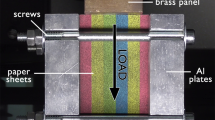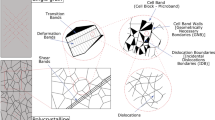Abstract
A model problem in finite elastoplasticity with one active slip system in two dimensions is considered. It is based on the multiplicative decomposition of the deformation gradient and includes an elastic response, dissipation and linear hardening. The focus lies on deformation theory of plasticity, which corresponds to a single time step in the variational formulation of the incremental problem. The formation of microstructures in different regions of phase space is analyzed, and it is shown that first-order laminates play an important role in the regime, where both dissipation and hardening are relevant, with second- and third-order laminates reducing the energy even further. No numerical evidence for laminates of order four or higher is found. For large shear and bulk modulus, numerical convergence to the rigid-plastic regime is verified. The main tool is an algorithm for the efficient search for optimal microstructures, which are determined by minimization of the condensed energy. The presently used algorithm and code are extensions of those previously developed for the study of relaxation in sheets of nematic elastomers.













Similar content being viewed by others
References
Ortiz, M., Repetto, E.A.: Nonconvex energy minimization and dislocation structures in ductile single crystals. J. Mech. Phys. Solids 47(2), 397–462 (1999)
Carstensen, C., Hackl, K., Mielke, A.: Non-convex potentials and microstructures in finite-strain plasticity. R. Soc. Lond. Proc. Ser. A 458(2018), 299–317 (2002)
Kröner, E.: Allgemeine Kontinuumstheorie der Versetzungen und Eigenspannungen. Arch. Ration. Mech. Anal. 4, 273–334 (1960)
Lee, E.H.: Elastic-plastic deformation at finite strains. J. Appl. Mech. 36, 1–5 (1969)
Reina, C., Conti, S.: Kinematic description of crystal plasticity in the finite kinematic framework: a micromechanical understanding of \(F=F^e F^p\). J. Mech. Phys. Solids 67, 40–61 (2014)
Mariano, P.M.: Covariance in plasticity. R. Soc. Lond. Proc. Ser. A 469, 20130073 (2013)
Morrey Jr., C.B.: Quasi-convexity and the lower semicontinuity of multiple integrals. Pac. J. Math. 2, 25–53 (1952)
Dacorogna, B.: Direct Methods in the Calculus of Variations, vol. 78. Springer, Berlin (2007)
Müller, S.: Variational models for microstructure and phase transitions. In: Bethuel, F., et al. (eds.) Calculus of Variations and Geometric Evolution Problems, Springer Lecture Notes in Math. 1713, pp. 85–210. Springer, Berlin (1999)
Conti, S., Dolzmann, G.: An adaptive relaxation algorithm for multiscale problems and application to nematic elastomers. J. Mech. Phys. Solids 113, 126–143 (2018)
Parry, G.P.: On the planar rank-one convexity condition. Proc. R. Soc. Edinb. Sect. A 125(2), 247–264 (1995)
Kohn, R.V., Strang, G.: Optimal design and relaxation of variational problems. II. Commun. Pure Appl. Math. 39, 139–182 (1986)
Conti, S., Theil, F.: Single-slip elastoplastic microstructures. Arch. Ration. Mech. Anal. 178, 125–148 (2005)
Conti, S.: Relaxation of single-slip single-crystal plasticity with linear hardening. In: Gumbsch, P. (ed.) Multiscale materials modeling, pp. 30–35. Fraunhofer IRB, Freiburg (2006)
Conti, S., Dolzmann, G., Kreisbeck, C.: Relaxation of a model in finite plasticity with two slip systems. Math. Models Methods Appl. Sci. 23, 2111–2128 (2013)
Conti, S., Dolzmann, G., Kreisbeck, C.: Asymptotic behavior of crystal plasticity with one slip system in the limit of rigid elasticity. SIAM J. Math. Anal. 43, 2337–2353 (2011)
Braides, A.: \(\Gamma \)-Convergence for Beginners, Oxford Lecture Series in Mathematics and its Applications, vol. 22. Oxford University Press, Oxford (2002)
Dal Maso, G.: An Introduction to \(\Gamma \)-Convergence. Progress in Nonlinear Differential Equations and their Applications, 8. Birkhäuser Boston Inc., Boston (1993)
Press, W.H., Teukolsky, S.A., Vetterling, W.T., Flannery, B.P.: Numerical Recipes 3rd Edition: The Art of Scientific Computing, 3rd edn. Cambridge University Press, New York (2007)
Conti, S., Dolzmann, G., Klust, C.: Relaxation of a class of variational models in crystal plasticity. R. Soc. Lond. Proc. Ser. A 465, 1735–1742 (2009)
Pitteri, M., Zanzotto, G.: Continuum Models for Phase Transitions and Twinning in Crystals, Applied Mathematics (Boca Raton), vol. 19. Chapman & Hall/CRC, Boca Raton (2003)
Miehe, C., Lambrecht, M., Gürses, E.: Analysis of material instabilities in inelastic solids by incremental energy minimization and relaxation methods: evolving deformation microstructures in finite plasticity. J. Mech. Phys. Solids 52, 2725–2769 (2004)
Bartels, S., Carstensen, C., Hackl, K., Hoppe, U.: Effective relaxation for microstructure simulations: algorithms and applications. Comput. Methods Appl. Mech. Eng. 193, 5143–5175 (2004)
Carstensen, C., Conti, S., Orlando, A.: Mixed analytical-numerical relaxation in finite single-slip crystal plasticity. Contin. Mech. Thermod. 20, 275–301 (2008)
Acknowledgements
This work was partially supported by the Deutsche Forschungsgemeinschaft through the Sonderforschungsbereich 1060 “The mathematics of emergent effects,” project A5.
Author information
Authors and Affiliations
Corresponding author
Additional information
Publisher's Note
Springer Nature remains neutral with regard to jurisdictional claims in published maps and institutional affiliations.
Rights and permissions
About this article
Cite this article
Conti, S., Dolzmann, G. Numerical Study of Microstructures in Single-Slip Finite Elastoplasticity. J Optim Theory Appl 184, 43–60 (2020). https://doi.org/10.1007/s10957-018-01460-0
Received:
Accepted:
Published:
Issue Date:
DOI: https://doi.org/10.1007/s10957-018-01460-0




